Swords and Sports Cars
- Asante Lawla
- Apr 22, 2023
- 9 min read
Updated: Sep 19, 2024
When I first found Shastar Vidiya, an indian battlefield art, one thing that immediately stood out to me was the system’s incredible attention to detail. Whether it was strategy, body mechanics, psychology or even underfoot conditions, evidently everything was carefully examined. But nowhere is this attention to detail more obvious than in the design of the various weapons used in the art. One of my more memorable moments when first attending a seminar, was getting to hold a variety of antique swords. This highlighted to me just how much difference there is between an extremely well-balanced antique, and just an “ok” one.
Coming from an engineering background, I found these differences fascinating. Even some of the larger more cumbersome looking weapons felt astonishingly light in hand and were surprisingly easy to wield. This led me to create this quick guide on what makes a good sword in Shastar Vidiya and why we aim for those qualities.
Control
When choosing a sword, we want it to be as easy to control as possible, as well as easy to “draw-cut” with. Meaning a sword which comfortably generates speed/power, but requires minimal effort to manipulate.
Just like in cars, this largely comes down to stability and response. To achieve this, engineers focus on maintaining contact with the ground using suspension/stability systems and tuning engines for a smooth and predictable response pattern.
Similarly, we look at how our hand makes contacts with the hilt, and how stability contributes to power and control. To understand this, let’s take a look at tipping point design and its role stabilisation.
Stabilisation
An object will naturally stabilise itself and return to an equilibrium if its center of mass (COM) does not move beyond a tipping point (fig 1). This is known as static stability, and though it does not entirely determine how an object behaves dynamically, it does give us a pretty good indication. But stability can be a good or bad thing depending on the application.
In shipbuilding for example, you want tons of stability and a large separation between tipping points to prevent the ship from capsizing. However, when designing an electrical switch, you want to minimise stability to reduce the energy required to flip the switch and ensure switches actuate quickly, preventing arc damage.
With swords, we want a combination of both. Tipping points which reduce the energy required to move or hold the blade in certain ways, but enough stabilisation to reduce strain on the wrist whilst wielding it.
Fig 1
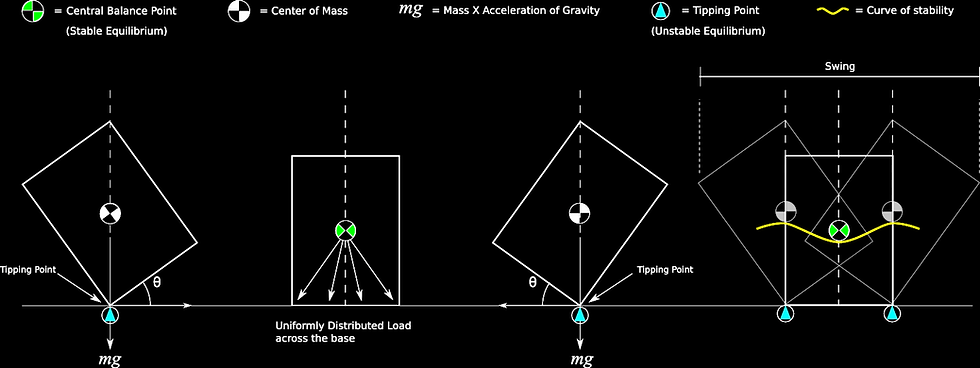
Returning to the car analogy, we’re looking at how stiff or soft we want our suspension to be. This determines how far a car will sway and how fast it will correct itself. Too hard or too soft and you risk some wheels leaving the ground and others taking all the strain, causing a loss of control.
Fig 2

Muscles in the forearm perform a similar job when wielding a sword. Like suspension, they work in opposing pairs and have optimal length-tension relationships (fig 3), determined by the angle of the wrist. The closer your muscles are to their length at rest, the more force they can produce. The further you move from this angle the more strain you put on the muscles and ligaments, reducing your control of the sword.
Fig 3
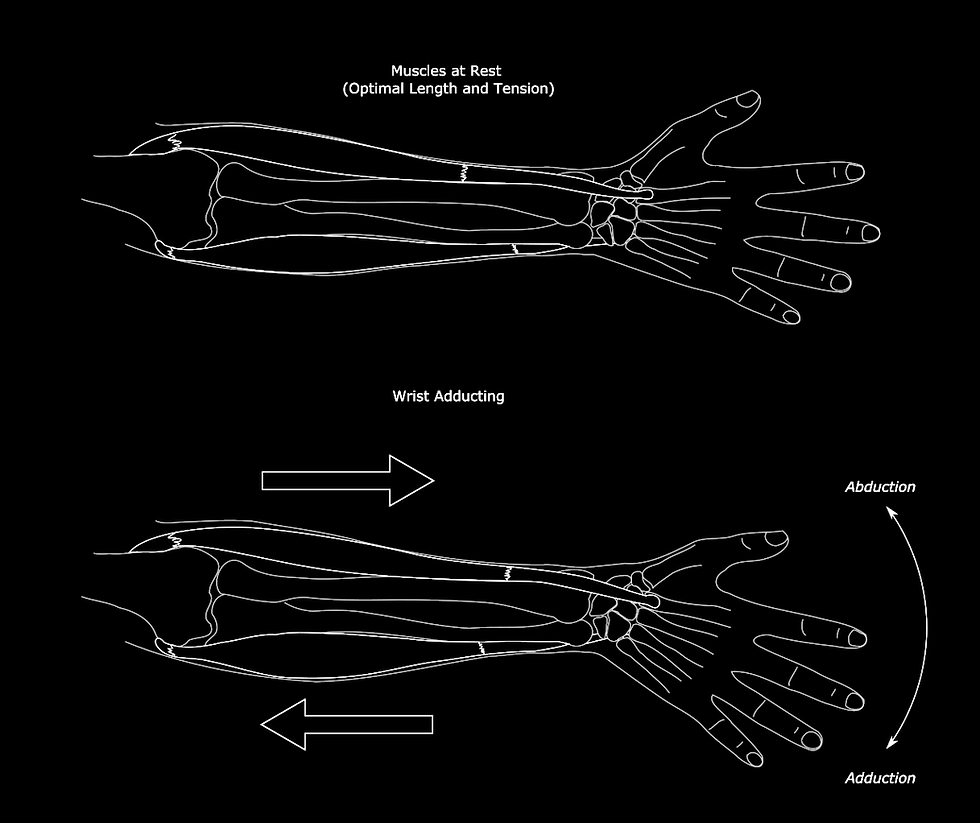
For example, the sword below has a low COM quite near the hilt (fig 2). By reducing the COM’s distance from the fulcrum we increase our leverage. But the sword will also be reluctant to rotate and generate less angular momentum (which I’ll talk about more later). This reduces its relative power for cutting and places the tipping points beyond our wrist’s normal range of motion when wielding.
Fig 4

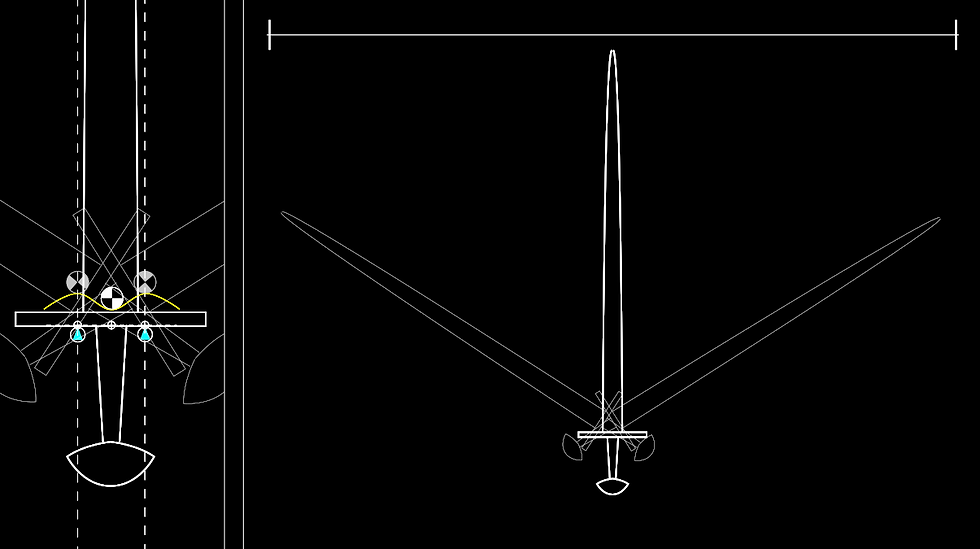
Though the almost horizontal tipping position of this sword, and reluctance to fall forwards would be ideal for a thrusting grip/style. This is the opposite of what we’re aiming for when draw-cutting in Shastar Vidiya. Draw cuts start somewhat like a punch with the sword fairly upright (perpendicular to the forearm), before falling through the target using as much of the edge as possible.
Conversely, if we have a sword with a high COM (fig 5), the sword would feel eager to fall forwards and generate a lot of angular momentum for cutting. But in exchange our leverage would decrease considerably, putting more strain on the wrist. As for the tipping points, the separation between them would be too small to be useful. Just a little rotation would push the sword past its tipping point and prevent us using stabilisation to assist in controlling the weapon.
Fig 5

Fit
Now that we understand stability, let's begin checking the fit of our sword.
The plate on the bottom of the hilt should create a snug fit to the hand so that the little finger and heel of the palm are in contact with it. This secures the hilt in the hand, reduces play a
nd provides greater purchase for draw cutting. The contours of the hilt itself should closely match the varying heights of the interphalangeal joints on the fingers. When combined with the narrower section of hilt near the plate, this will bring interphalangeal joints into vertical alignment with the blade edge. In this way, edge alignment remains intuitive and ergonomic.
In its entirety, the Indo-Persian hilt is designed to maximize dexterity. Rather than using just the shaft of the hilt, we press and pull on the plate, whilst the thumb and index finger/knuckle use the quillon to inform and adjust our edge alignment. The plate also helps to prevent bad habits like overextending the wrist.
Fig 6
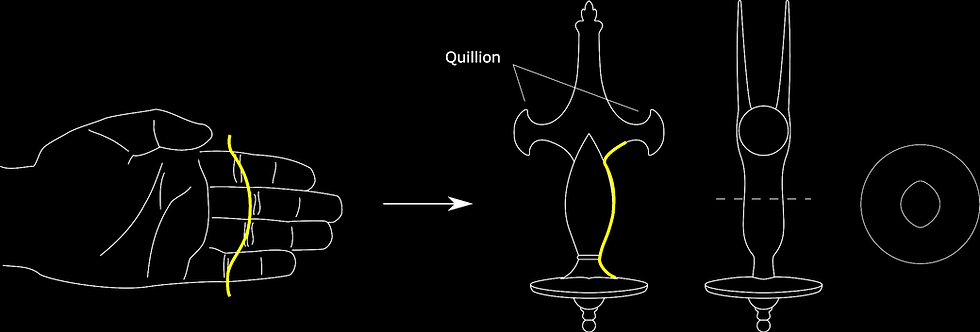

Balance
The first thing we check when assessing sword balance is its central equilibrium point. We want the sword to be balanced in such a way that it's slightly tilting forwards.
Meaning the sword will naturally move to a more relaxed wrist angle. As a result, holding the sword will immediately feel less strenuous. Better swords will also have what we call a “gun hilt”, where the base of the hilt is shifted forwards with the little finger sitting just in front of the COM line. This allows it to act as both a “trigger” and backstop for rotation.
Fig 7

The rear tipping point should align the center of mass with the sword oriented as close to upright as possible. By doing so, the sword is less likely to rotate backwards when retracting the blade, and is faster off the mark from an upright position. Keep in mind the wrist has quite limited abduction (backwards rotation) and the closer you get to this limit the more strenuous it will feel. If the sword's rear tipping point is set too far back, it can feel almost like the sword has a lot of "drag" from drawn back positions.
Fig 8

Finally the front tipping point should bring the wrist to a tilt roughly between 15 and 30 degrees. This range of movement is where the wrist will feel strongest for cutting, aligning the index and thumb knuckles with the forearm for better support against buckling. This angle range can also be found on most pistol grips, as it helps to reduce muzzle flip in the same manner. We want to be close to the middle of that range, ensuring a low energy requirement for adjustments within it.
Fig 9
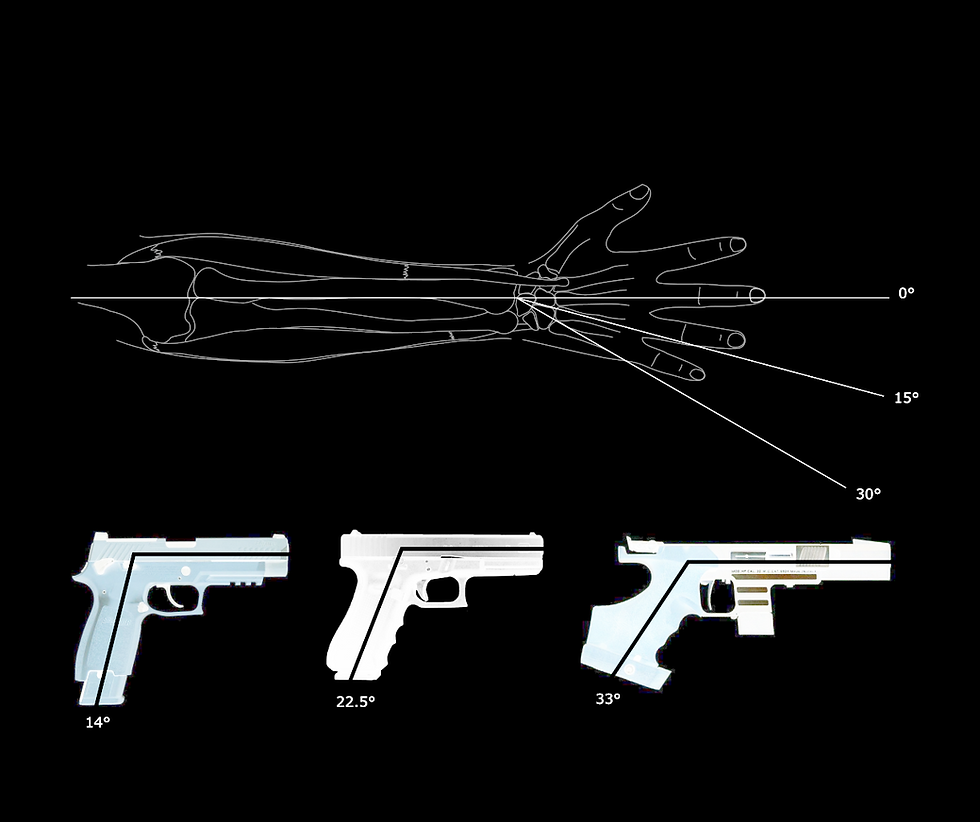
In this position the centre of mass should align vertically with the tip of the sword. Reducing the effort required to find and maintain good wrist posture for both cutting and thrusting. (Our thrusting technique with a curved sword is more of a hooking motion)
Should the sword reach its tipping point after the wrist reaches an "ideal tilt", the sword will feel reluctant to hold the position.
Fig 10

Rotational Inertia and Momentum
Once the sword has moved beyond the tipping point, we rely largely on using the sword's mass and innate rotational qualities to wield it and perform cuts. So after ensuring the sword feels well balanced statically, we check how it behaves dynamically, by performing a bounce and drop test.
Before that, let’s quickly go over what angular momentum actually is.
Inertia and momentum are two sides of the same coin. We can describe an object's inertia as how much effort it takes to move it and its momentum as how hard it is to stop it from moving. The more mass something has, the harder it is to move, and the more velocity (speed) it has, the harder it is to stop. The only difference with angular momentum is that the velocity mentioned is rotational.
So, momentum is simply Mass x Velocity. In other words Mass x the Distance you’re able to cover in a certain amount of Time. Well, the further you are from the centre of a wheel, the more distance you will cover as you travel around it. This is because you will move in a larger circumference, which is why Olympic runners start at different points on a track. In that way, a fair race is ensured, as everyone runs the same distance.
Looking at the diagram and assuming both cars have the same mass. It should be clear that the green car travelled further in the same amount of time, and thus had more momentum. It would also require more energy to cover that distance. Applying this to swords, the further the center of mass is from the hilt (the center of rotation) the harder it becomes to stop the sword from rotating, which can be great for cutting, but makes wielding more difficult.

In our tests, we look for smooth and predictable changes in angular momentum, inertia, and velocity. There are some more specific qualities we look for when assessing specialised weapons like Khandas, Kirachs and Kukris, to aid the way in which they are used. But for typical Golias, Teghs and Teghas, our main priority is smoothness.
When a sword moves smoothly and in a predictable manner, we can keep pressure changes consistent in our hand, which reduces wrist strain. As I mentioned in the beginning
ng, this is a lot like tuning performance cars where drivers want the same qualities in their engine’s power output. Imagine accelerating out of a corner at high speed when suddenly the engine jumps up in torque unpredictably. This would completely throw you off and make the car very difficult to control. Good engine response looks something like the picture below. Here power output responds almost uniformly to increased engine speed. On a poorly tuned car (or a car tuned for a different purpose), you’d expect to see sharp changes in power output, often caused by things like the infamous turbo lag.

Similarly the bounce test, checks how our swords respond to being held at different angles.
To perform the bounce test, you gently bounce your sword against your forearm (wearing something protective) whilst moving through a full range of motion for a draw cut. Starting from the tip we make our way towards the hilt. The idea is to try to keep the bounce height as consistent as possible, whilst monitoring the feel in the hilt. With a very* well-balanced sword you should make it all the way to the hilt, without any drastic or unexpected changes. The distance between the tip of the sword and the point at which you feel the change, determines the quality of the sword's dynamic properties. The shorter that length is, the less well dynamically* balanced the sword is.
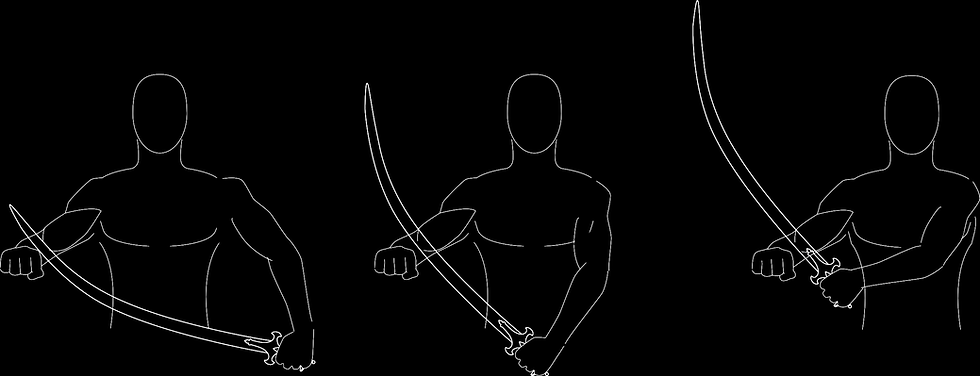
Performing the bounce test requires a certain amount of sensitivity and experience to get the hang of, but I've created an approximation of the more simple drop test using physics simulation software.
The GIF below shows what is known as a double pendulum test which is highly sensitive to initial conditions and physical properties of an object. It allows physicists to study dynamic behaviour in more detail. In the past it has been used in studying sports like golf, cricket and tennis to analyse the efficiency in human movement and the performance of sporting equipment. One study even goes as far as using this experiment in an attempt to design the “perfect” bat. But that’s far beyond the scope of this article.
I’m using this test to simply show how the shape of a weapon can affect its angular acceleration and momentum when acted on by gravity.
In the middle and to the left you have 2 setups with identical mass but different shapes. These are references which show how a shape alone can influence angular momentum/acceleration. On the right is a shape which resembles a typical Sirohi which we’ll be testing. The limbs on the test represent our upper arm and forearm, and their initial positions are where we’d begin a real drop test.

Looking at the angular momentum over time graph for the Sirohi shape, and comparing it to the reference shapes. We can see that the taper and shape of the Sirohi have managed to keep the changes in momentum relatively flat and smooth. Assuming it has good stability, this would be a very comfortable sword to wield.
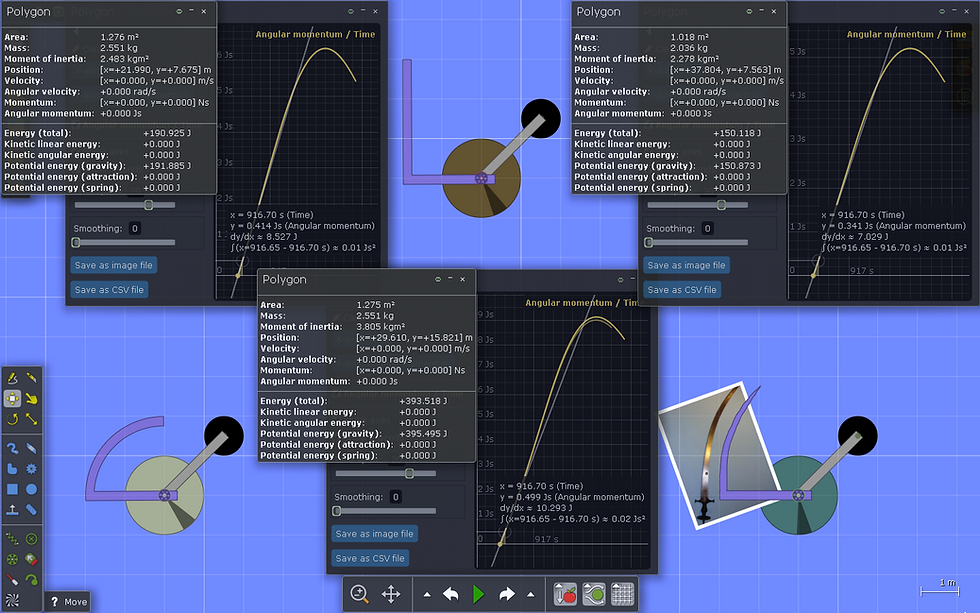
As for changes in angular velocity, although the straight shape generated the most angular momentum, it is slower off the mark than the circular and Sirohi shape. It also picks up speed quite suddenly after its initial movement. This could potentially make it more difficult to wield.
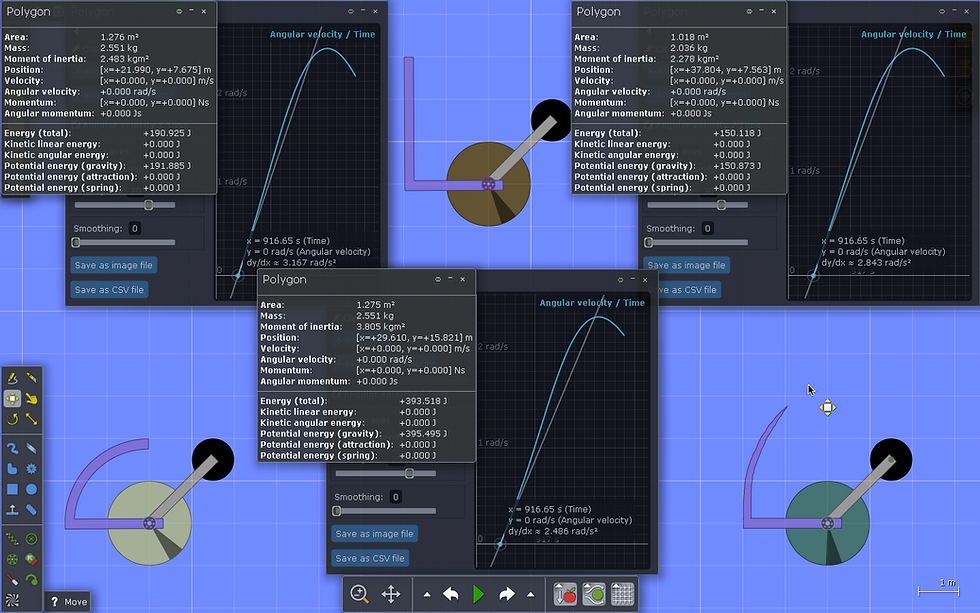
TLDR
In summary, when assessing the balance of a sword, we look at its range of stability and its tipping points. A good sword has tipping points which keep the sword between our desired range of motion at the wrist. In doing so, the sword’s stability can reduce strain on the wrist by assisting our muscles when wielding. After assessing static stability, we assess the dynamic properties of the sword using a bounce and drop test. These tests reveal the swords rotational inertia when held at different angles, and how smoothly the sword will accelerate when wielded.
In addition to the elements we've already spoken about, here are some other features we look for in swords;
Period - This is affected by the weight of the blade in relation to the weight of the hilt. A short period will speed up instability corrections giving the blade a "flame like" quality, allowing it to dance in the hand.
T-Spine - This makes the blade lighter overall without losing too much rigidity.
Diamond Tip - This improves thrusting ability especially against armour.
False Edge - A double edged top portion of the sword, would improve what we call "plucking" strikes. (Hooking thrust, typically aimed towards the eyes/throat).
Hopefully, this article has given you some insight into how we judge the balance and usability of Indo-Persian weapons in SV.
Sound Off !






Comments